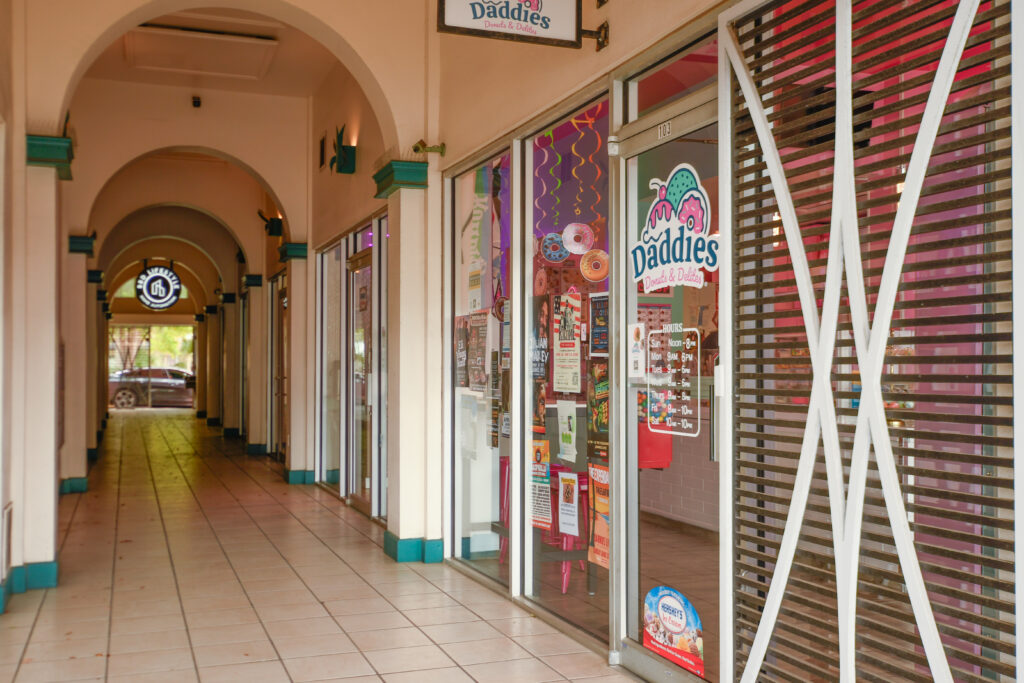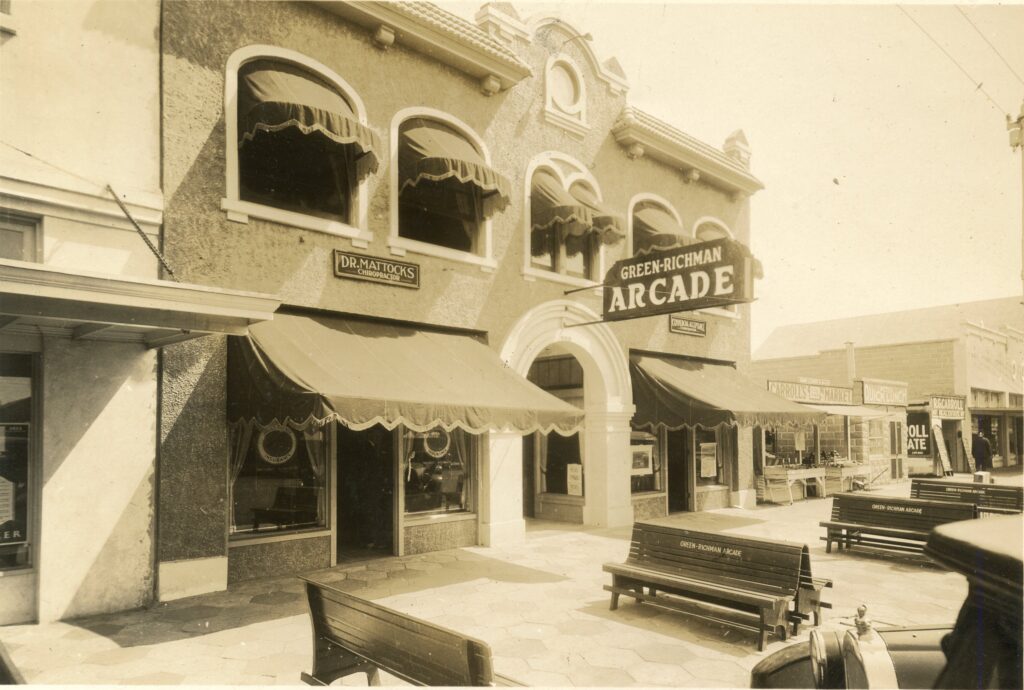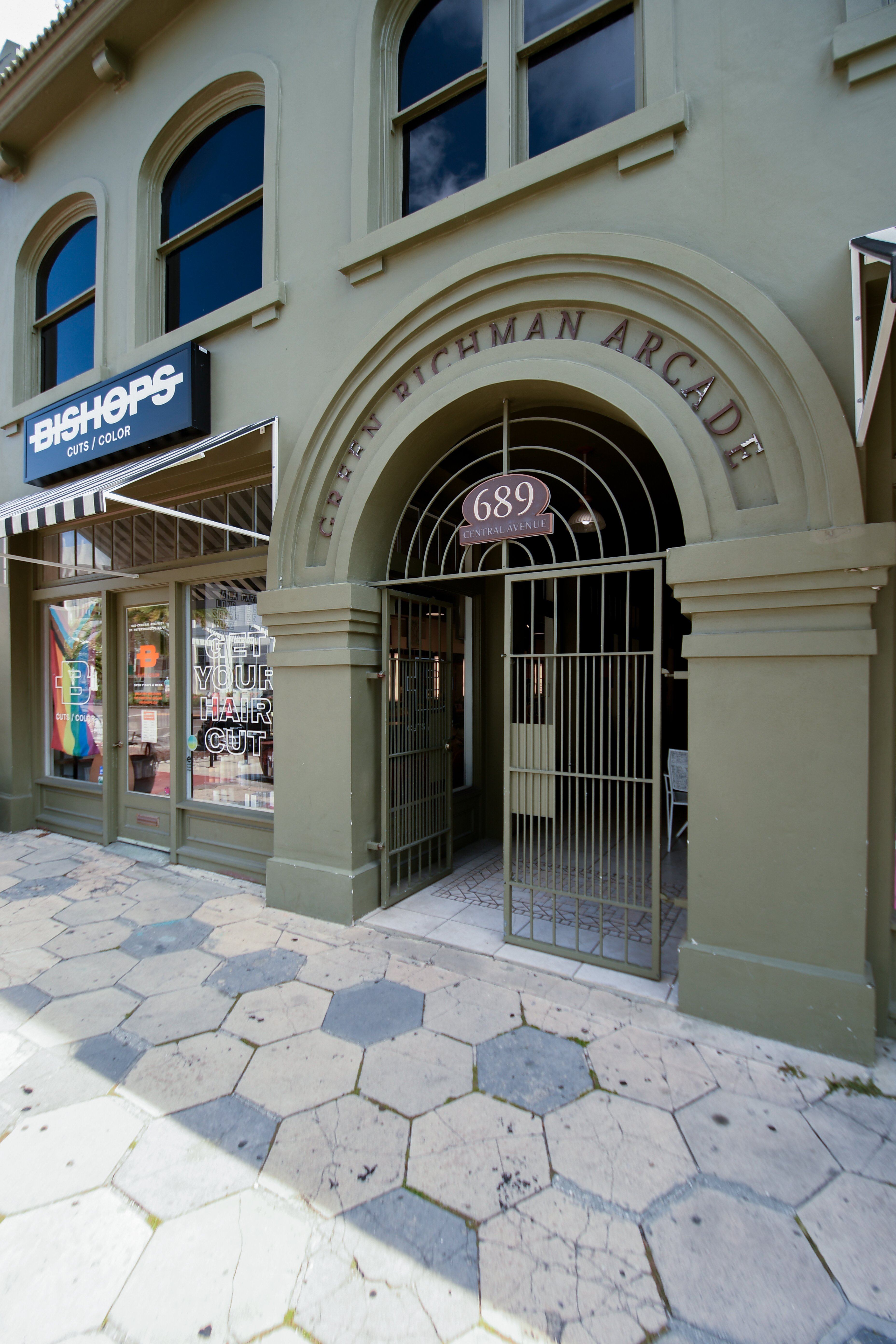French architect Bertrand Lemoine called the period from 1786-1935 in Europe the l’ère des passages couverts, or the Era of the Arcades, in reference to the grand shopping arcades that once graced the continent. These covered passages, characterized by the consecutive series of colonnaded arches that define the term arcade, later came to be associated more with the shops that filled the spaces between arches, than with the arches themselves.
St. Petersburg had its own Era of the Arcade, a period that lasted from roughly 1920 to 1927, when at least 11 arcades operated simultaneously in the city, most within a three-block span straddling Central Avenue. Like all trends, the arcades enjoyed a heyday, then fell out of favor, and once again are appreciated for their charm, utility, and uniqueness.
In addition to protection from the scorching sunshine and torrential downpours that mark St. Petersburg summers, arcades also offered walkers a convenient shortcut between blocks, and entrepreneurs a place to start out. By dividing a building into multiple small shops accessed by a central passageway, arcades offered small, affordable spaces for new businesses. Often referred to as booths or stalls, the stores were usually 20 feet deep, rather than the traditional 100 feet of a full-sized store. The space is perfect for flower shops, hat stores, fruit markets, real estate offices, candy stores, and barber shops.
Train tickets, a hotel, a theater
St. Pete’s first arcade was built just after the turn of the last century; you could buy a train ticket from an Atlantic Coast Line agent there in 1903. By 1910, it was joined by the Tonnelier Arcade, with the Arcade Hotel on its second floor, on the 200 block of Central Avenue. By 1920, George Gandy (of bridge fame) added an arcade to his existing La Plaza Theater on Central Avenue and 6th Street. Over the next several years, nearly a dozen new arcades would be built downtown. The Era of the Arcade had arrived.
In 1923, the striking Alhambra Arcade was built on the corner of First Avenue N and Sixth Street. With a central courtyard, tinted stucco, and high-arched windows, the Alhambra was meant to evoke Spanish elegance. Its interior courtyard could be accessed via arcades from both Fifth Street and First Avenue, making this the first of two L-shaped arcades in the city. The second, the Taylor Arcade, was built in 1925 by “Handsome Jack” Taylor, builder of the Rolyat Hotel (today’s Stetson College of Law). Designed by prominent architects Kiehnel and Elliot, the L-shaped Taylor Arcade provided additional store frontage, with the added bonus of a more scenic route around a corner – a boon to shop owners who enjoyed the frequent passersby that took advantage of it.
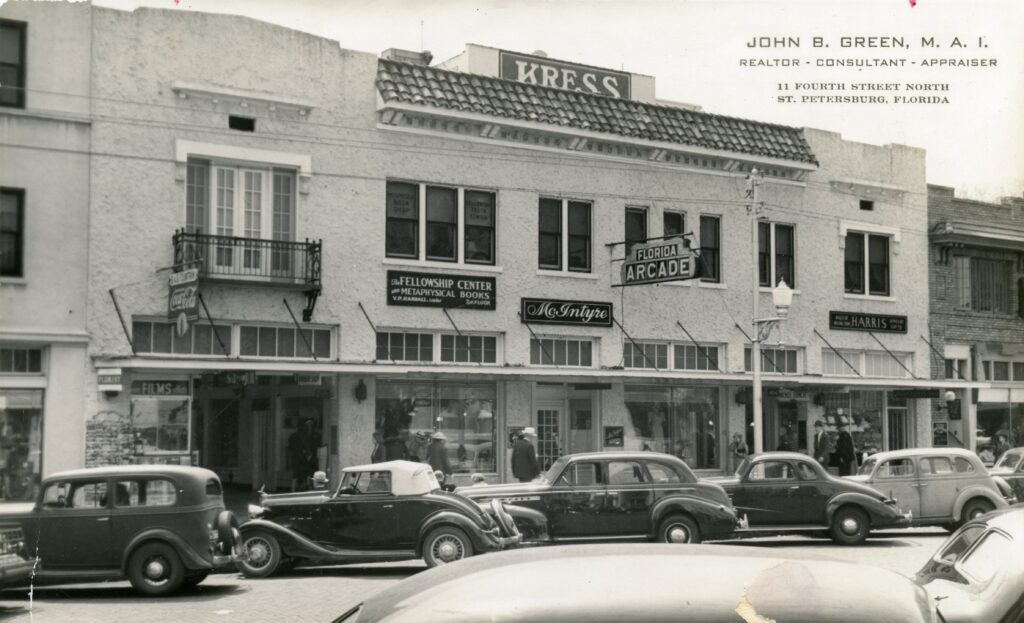
Built on a diagonal
Arcades set on a diagonal proved to be even more convenient, significantly cutting the time it took to walk between blocks. Users of the Florida and Magnolia arcades knew this well. One could enter the Florida Arcade on the 400 block of Central Avenue (still open today) and walk to the alley. There, one could continue straight through the second half of the Florida Arcade on First Avenue N or cut diagonally through the Magnolia Arcade, which ended next to the Open Air Post Office. The Magnolia, named for the graceful trees located in front of the building, was home to the popular Bill’s Shoe Repair and local institution Kauffman’s Jewelers for more than 60 years. One tenant reminisced that while customers waited, they could have the rubber insert in their “fountain pen changed for 50 cents by a guy named Balls of Fire.” The Magnolia and the north side of the Florida Arcade were both demolished in 1996 and remain empty lots today.
The building of the Central, the Crislip, the Green-Richman, and the Snell Arcades rounded out the 1920s Arcade Era. The latter three, along with the southern half of the Florida Arcade, remain intact and open today. Many of the original arcades were enclosed over the years, their interior walls demolished to create one large space. In this way, the Taylor Arcade became the second location of the Tramor Cafeteria in 1934. Likewise, the former Mitchell Arcade, built in 1925 on First Avenue N and Sixth Street (site of today’s courthouse), became the Dixie Cafeteria in 1929, one of the most popular eating establishments in the city for more than 25 years.
Restoration of a beauty
The stunning Snell Arcade, also designed by Kiehnel and Elliott in 1926, later suffered the indignity of becoming a Walgreen’s drugstore, and then quotidian office space. Its Spanish tile floors were covered in carpeting, decorative columns topped by European statues were removed, the mezzanine level with its soaring skylight was closed in to create a second floor, and its enormous mosaic tile rendering of a Venetian church was hidden away in storage. Fortunately for the citizens of St. Petersburg, the Snell Arcade was lovingly restored in the early 1980s. Anyone can now walk through the strikingly ornate passage and feel like they’ve stepped into a Venetian palazzo. Ironically, the Snell Arcade, arguably the most beautiful building standing in St. Petersburg today, was initially criticized by residents in the 1920s because its arcade wasn’t as good a shortcut as that of its predecessor, a wood-frame building with an arcade set on the diagonal.
Most of the 1920s arcades were eventually demolished during the downtown doldrums of the 1960s to the early 1990s, often for parking lots that the city hoped would spur the return of shoppers lured away from downtown by the spacious parking lots of suburban shopping centers. The Crislip Arcade, built in 1925 by a prominent local mortician, narrowly missed a similar fate in the real-estate boom of the early 2000s, when it was proposed for demolition to make way for a high-rise condo. Luckily, a creative alternative was reached by preservationists, artists, Realtors, and the property owner, and the space was revived with art galleries and boutiques. Today, it is the centerpiece of the most vibrant block of Central Avenue. Nearby, the attractive Green-Richman Arcade still serves as a shortcut for office workers along Mirror Lake going for a quick bite to eat on Central Avenue.
New pass-throughs
The concept of the shortcut through blocks may be making a comeback in St. Petersburg as two new developments in the Edge District make use of the “paseo,” a walkway or promenade between buildings. Architect Everald Colas of Storyn Architecture, designers of the Moxy Hotel currently being built on Central Avenue near 13th Street, noted: “Paseo and arcades are similar in spirit. They are snuck between buildings as a respite, shortcut, or a unique ground-floor activation. The term, as used in our project at the Moxy, was inspired by the Crislip and Snell arcades, as these were tertiary spaces that allowed someone to move north-south in between buildings.”
Could the paseo usher in a new Era of the Arcades? One can dream. Shade, shopping, and a shortcut – what’s not to love?
—————————————————————————————————-
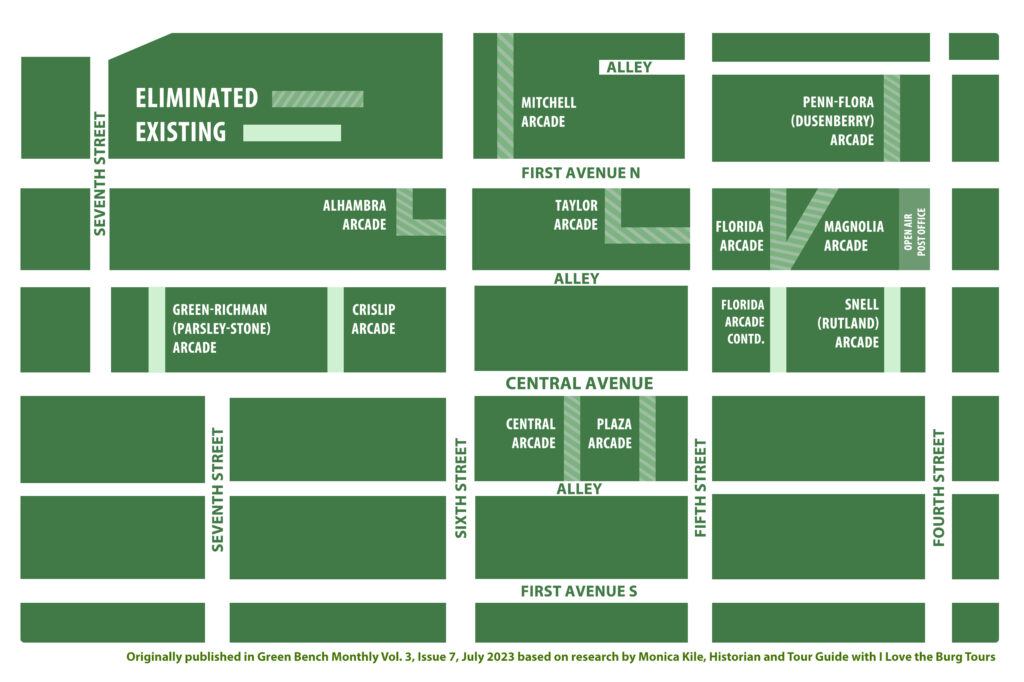
Demolished
- Tonnelier Arcade – 1910-ca. 1922. 250-260 Central Ave.
- La Plaza Arcade – 1920-1957. 504 Central Ave. Part of La Plaza Theater.
- Englewood Arcade – 1920-1924. 516 Central Ave. Either converted or demolished.
- Alhambra Arcade – 1923-1963. Corner of First Ave N and 6th Street. L Shaped.
- Central Arcade – 1923-1942. 526 Central Ave. Converted, then later demolished.
- Florida Arcade – 1924-1995. at 458 First Ave N. (Central Avenue portion remains standing.)
- Magnolia Arcade – 1925-1995. First Ave N, next to Open Air Post Office. Diagonal.
- Plaza Arcade 1925-?. First Ave N between Fifth and Sixth streets.
- Taylor Arcade – 1925-1957. First Avenue N and Fifth Street. L shaped. Converted and later demolished.
- Penn-Flora Arcade – 1926-1963. 445 First Ave N. Later the Dusenberry Arcade.
- Mitchell Arcade – 1925-1929 (converted). 551 First Ave. N. Later demolished.
- Schooley-Murphy Arcade – 1936-1939. 554-552 First Ave North. Probably a traditional building that was temporarily converted to an arcade. Connected through alley to Woolworth’s on Central Avenue.
Still Standing
- Florida Arcade – 1924-present. 449 Central Ave.
- Crislip Arcade – 1925-present. 645 Central Ave.
- Snell Arcade – 1926-present. 405 Central Ave.
- Green-Richman Arcade – 1926-still standing. 689 Central Ave. Was also called the Parsley and Stone Arcade for many years.




